All Management News
- Dr. Neeraj Kumar Sharma April 28, 2020
- Preparing students to become a global leader April 28, 2020
Prof. Jayaseelan Murugaiyan on plethora of opportunities at SRM AP
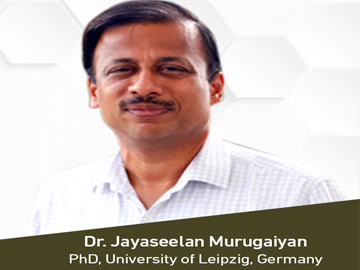 SRM AP, Andhra Pradesh brings an opportunity for the aspiring students to stay informed and ahead of their peers. Through a webinar hosted by Prof. Jayaseelan Murugaiyan, Professor and Head of the Department, Biology & Biotechnology, Ph.D. program admission coordinator, the exceptional SLABS program of the university was highlighted. Prof. Jayaseelan introduced SRM AP through a video enunciating the faculty, research, and students. He spoke of the higher education, job, and research opportunities that a student can expect after graduating from SRM AP. “SRM AP is a research-based university located amidst the greenery accentuating its green campus.”, says Prof. Jayaseelan.
SRM AP, Andhra Pradesh brings an opportunity for the aspiring students to stay informed and ahead of their peers. Through a webinar hosted by Prof. Jayaseelan Murugaiyan, Professor and Head of the Department, Biology & Biotechnology, Ph.D. program admission coordinator, the exceptional SLABS program of the university was highlighted. Prof. Jayaseelan introduced SRM AP through a video enunciating the faculty, research, and students. He spoke of the higher education, job, and research opportunities that a student can expect after graduating from SRM AP. “SRM AP is a research-based university located amidst the greenery accentuating its green campus.”, says Prof. Jayaseelan.In this webinar, Prof. Jayaseelan discusses about the 10 departments of SLABS that offer various degrees including B.Sc. (Hons.) and B.A. (Hons.). In addition, 6 foundation courses are made compulsory to broaden the learning sphere of the students. The multi-disciplinary curriculum equips the students to be prepared and compatible with the industry requirements, improving their employability in the global market. Prof. Jayaseelan asserts, “Since the disciplines are blurring and blending, the unique foundation courses make our students leaders in their field”.
All the faculty of SRM AP hold Ph. D from renowned Indian and international institutes along with extensive global exposure. They provide excellent mentorship to the students in terms of higher education, research, and national/foreign internships. They also guide the students to pursue the ideal career paths.
Prof. Jayaseelan further discusses the course structure which includes 3 years of the degree course and 1 year additional for availing diploma course, if the students opt for the same. The diploma course focuses on preparing the students for a master’s program abroad. Prof. Jayaseelan informs, “We believe in strong theoretical knowledge and confidence in handling instrumentation and equipment’s is important whether it be for higher studies, finding job or to venture own ideas as a successful entrepreneur.”
SRM AP has active learning centers where 5-6 students are grouped, and the groups are urged to discuss current challenges and issues of the study field. This challenging framework nurtures the spirit of teamwork and improves the problem-solving abilities of the students. They emerge with a clear understanding of concepts as the discussions widen their knowledge base.
The webinar concluded with a question and answer session. Among 77 students who attended the session, many of them proactively inquired on basic curriculum, module, credit system, core courses, electives, and diploma course. When a student requested Prof. Jayaseelan to enlighten them on internships offered to the senior students, he explained that a student did her internship from JNCASR, a massive opportunity rarely provided to undergraduate students. Furthermore, he explained the selection process where the applicants will be called for a written test/interview. The panel evaluates the intent and analysing ability of the students instead of testing their memorizing skills. Apply Here
Prof. Jayaseelan also updates that SRM AP has training cells, Fablab, and Next Tech Lab, where the students get an edge over their peers. Along with it, students talk on nationally/internationally recognized journals during frequent colloquiums organized by SRM AP. Furthermore, the professor informs that faculty trained from MIT University is about to open another cell at SRM AP to encourage the budding entrepreneurs, where their ideas will be complemented with proper planning and direction. The SLABS program has opportunities galore in store for young minds interested in every realm.
Continue reading → - Small-World Wireless Sensor Network to Help Making Smart Applications for Industries April 26, 2020
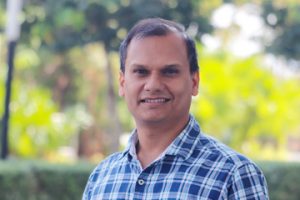 Dr Om Jee Pandey, Assistant Professor, Department of Electronics and Communication Engineering, has recently published two papers in renowned IEEE journals. His paper “Secrecy Performance Analysis of Two-way Relay Non-Orthogonal Multiple Access Systems” was published in IEEE Access Journal, having an impact factor: 4.06. Whereas, “Fault-Resilient Distributed Detection and Estimation over an SW-WSN Using LCMV Beamforming” was published in IEEE Transactions in Network and Service Management (Impact factor: 4.682). The study was done in associations with Prof. Rajesh M Hegde, Department of Electrical Engineering, IIT Kanpur and Prof. Ha H. Nguyen, Department of Electrical and Computer Engineering, University of Saskatchewan, Saskatoon, Canada. His research was focused on developing efficient Wireless Sensor Network services in small-world models. The proposed research can be applied in developing many state-of-the-art applications in the areas related to healthcare systems, climate-smart agriculture, intelligent transportation, home automation, manufacturing, smart utilities, and industries etc.
Dr Om Jee Pandey, Assistant Professor, Department of Electronics and Communication Engineering, has recently published two papers in renowned IEEE journals. His paper “Secrecy Performance Analysis of Two-way Relay Non-Orthogonal Multiple Access Systems” was published in IEEE Access Journal, having an impact factor: 4.06. Whereas, “Fault-Resilient Distributed Detection and Estimation over an SW-WSN Using LCMV Beamforming” was published in IEEE Transactions in Network and Service Management (Impact factor: 4.682). The study was done in associations with Prof. Rajesh M Hegde, Department of Electrical Engineering, IIT Kanpur and Prof. Ha H. Nguyen, Department of Electrical and Computer Engineering, University of Saskatchewan, Saskatoon, Canada. His research was focused on developing efficient Wireless Sensor Network services in small-world models. The proposed research can be applied in developing many state-of-the-art applications in the areas related to healthcare systems, climate-smart agriculture, intelligent transportation, home automation, manufacturing, smart utilities, and industries etc.In order to develop efficient Wireless Sensor Network (WSN) services, several methods have been proposed for node localization, clustering of sensor nodes, new routing algorithms, adaptive duty cycles, usage of mixed-transmission models, placement of intelligent gateways, usage of mobile elements, and bypassing holes. However, the introduction of small-world characteristics in a WSN has hitherto not been used in this context. A small-world network is typically characterized by a low average path length and high average clustering coefficient and has been widely used to model social networks. However, small world models have not been used in the development of WSN. The primary objective of this research is to develop small world models for WSN services such as sensor node localization, data gathering, data fusion, network lifetime maximization, energy-balancing, reduced data transmission delay, time synchronization, energy-harvesting, and robust distributed detection and estimation. A small world WSN reduces the number of hops required for data transmission, and maximal utilization of sensor nodes closer to the sink. Other advantages of small world WSN include efficient bandwidth utilization, increased network lifetime, and fast convergence of event detection and parameter estimation. Small world WSN developed in tandem with novel routing strategies leads to improved WSN services for various applications.
In WSNs, sensor devices transfer the data cooperatively using multiple hops over a network. Multiple hops required for data transmission over a WSN leads to reduced network performance in the context of device localization, energy efficiency, energy balancing, data latency, speed of event detection and parameter estimation, and network robustness. This is because of poor distance estimation between sensor device pairs, maximum utilization of sensor devices closer to the sink, and a short radio range of sensor devices. Hence, the primary focus of this research work is to reduce the number of hops required for data transmission. In this context, Small World Characteristics (SWC) can be introduced in a WSN, leading to a small world WSN (SW-WSN). An SW-WSN is a well-connected network with reduced hop counts between node pairs.
Small world phenomena were first observed by Stanely Milgram in social connectivity of people. Later, it came out as a theory of “six degrees of separation”. Six degrees of separation claims that all people are six, or fewer, social connections away from each other. This theory is also known as the 6 Handshakes rule. Further, small-world phenomena have been investigated in graphs. Subsequently, SWC is observed in wireless networks. In general, small world WSNs (SW-WSNs) are characterized by low Average Path Length (APL) and high Average Clustering Coefficient (ACC). For an undirected WSN with N nodes, representing a regular network, the APL increases linearly with the number of nodes present in the network. On the other hand, in a WSN having SWC the APL, between two randomly selected nodes grows proportionally to the logarithm of the number of nodes in the network. “WSNs are spatial graphs, where links are created using radio connectivity. There is a limit on the radio range of a sensor node, hence in such networks, the long-range connections are generally absent. Thus, these networks are clustered, but they do not experience small-world phenomena. Hence, the primary focus of this work is to develop SW-WSN using various methods leading to efficient WSN services” explained Dr Pandey.
Dr Pandey is now busy to take the studies further. His future projects include-
Continue reading →
• Small World WSN (or SW-WSN) Development for Smart Healthcare.
• Cognitive SW-WSN for Energy-Efficient CPS and IoT applications.
• Climate Smart Agriculture using Cognitive SW Characteristics.
• Low-Latency and Intelligent Transportation over small world CPS.
• Multi Sensor Fusion over SW-WSN for CPS/IoT Applications.
• Information and Context Quality in WSN, IoT and CPS Networks. - Dr. Sriramulu Bojjagani April 24, 2020
- Dr. Saleti Sumalatha April 24, 2020
- Paradigm shift to sustainable systems April 20, 2020
Dr. Lakhveer proposes to reduce the cost of bioreactors
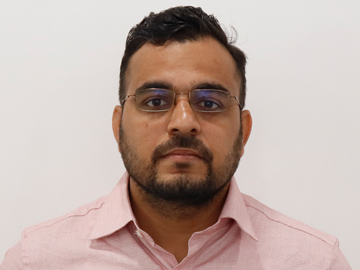 Reputed publishing house Elsevier has published the illuminating research work of Dr. Lakhveer Singh, Assistant Professor, Department of Environmental Science. The book named Bioreactors: Sustainable Design and Industrial Applications in Mitigation of GHG Emissions (1st Edition), is co-edited by Durga Mahapatra, Oregon State University, USA, Scientist and Dr Abu Yousuf, Assistant Professor, Shahjalal University of Science and Technology, Bangladesh.
Reputed publishing house Elsevier has published the illuminating research work of Dr. Lakhveer Singh, Assistant Professor, Department of Environmental Science. The book named Bioreactors: Sustainable Design and Industrial Applications in Mitigation of GHG Emissions (1st Edition), is co-edited by Durga Mahapatra, Oregon State University, USA, Scientist and Dr Abu Yousuf, Assistant Professor, Shahjalal University of Science and Technology, Bangladesh.Dawn of the 21st century has witnessed a solemn crisis in petroleum-derived fuels, consequently causing a major setback in chemicals/bio-products industries. Also, the researchers identify that the problem of climate change needs to be addressed by reducing the emission of greenhouse gases (GHGs). Dr. Lakhveer states, “To cope up with soaring energy demands, the present generation requires a paradigm shift from fossil-based resources to renewables and sustainable systems which accentuates the necessity of bioreactors for employing bioenergy and bio-products recovery”.
Presently, sophisticated bioreactor technologies have resulted in towering industrial production significantly contributing to the global economy and benefiting human life. Bioreactors have a substantial role in building a sustainable economy and providing food, feed, energy and other basic amenities for a quality life. Numerous bioreactors have evolved over time through sustainable research targeting commercialization.
A bioreactor is a vessel-like device that provides a uniform background for microorganisms to grow. It maintains an uninterrupted balance in the biochemical reactions carried out by these microorganisms to produce the desired metabolites. The applications of bioreactors extend to biomass production such as microalgae, single-cell protein, and yeast. For metabolite formation like organic acids, ethanol, antibiotics, aromatic compounds, and pigments, bioreactors are absolute. It also contributes to transforming substrates like steroids along with supplementing to production of both the intra and extracellular enzymes.
Recently, Dr Singh has developed an innovative cost-effective hybrid bioelectrochemical reactor (15.0 L) in collaboration with Oregon State University, USA, capable of generating efficient hydrogen at a cost less than $2/kg of H2 from lignocellulose hydrolysates or wastewater.
“In our research we have developed numerous types of bioreactors ranging in size from 5.0 to 100 L. A few examples are immobilized up-flow bioreactor, two-stage thermophilic and mesophilic fermenter, sequential dark and photobioreactor as well as hybrid bioelectrochemical reactor for bioenergy production and valuable products recovery from various industrial and agriculture waste. “ informs Dr. Lakhveer.
The book “Bioreactors” presents and compares the foundational concepts, state-of-the-art design and fabrication of bioreactors. Solidly based on theoretical fundamentals, it examines various aspects of the commercially available bioreactors, that includes construction, fabrication, design, modeling, simulation, development, operation, maintenance, management, and target applications for biofuels production as well as bio-waste management. Emerging issues in commercial feasibility are explored in the book along with covering the constraints and pathways for upscaling. It also carries out rigorous techno-economic assessment.
“This book provides researchers and engineers in the biofuels and waste management sectors a clear understanding of the actual potential of various advanced bioreactors for their requirements. It allows them to embark on informed decisions while selecting the appropriate technology models for sustainable systems development and commercialization”, says Dr. Lakhveer.
Advancing his work, Dr Singh is developing efficient and economical bioreactors for commercial applications in the energy and water sectors. In this regard, three international patents have been filed. In the next few months, two more of his books are to be published by American Chemical Society, ACS and Elsevier. The books will emphasize issues and frontiers of reactors technology such as operation, novel design, cost analysis, novel electrodes, nano catalytic materials and other extended applications of bioreactors.
Continue reading → - Young minds excelled at national level Hackathon April 5, 2020
Amidst the quarantine, students of SRM AP and members of NEXT TECH LAB, have exhibited their expertise in HACKNITR, a national level hackathon organized by NIT Rourkela on 21-22 March 2020. The outstanding merit of their project has enabled them to bag the Runner-Up and 2nd Runner-Up position at the hackathon.
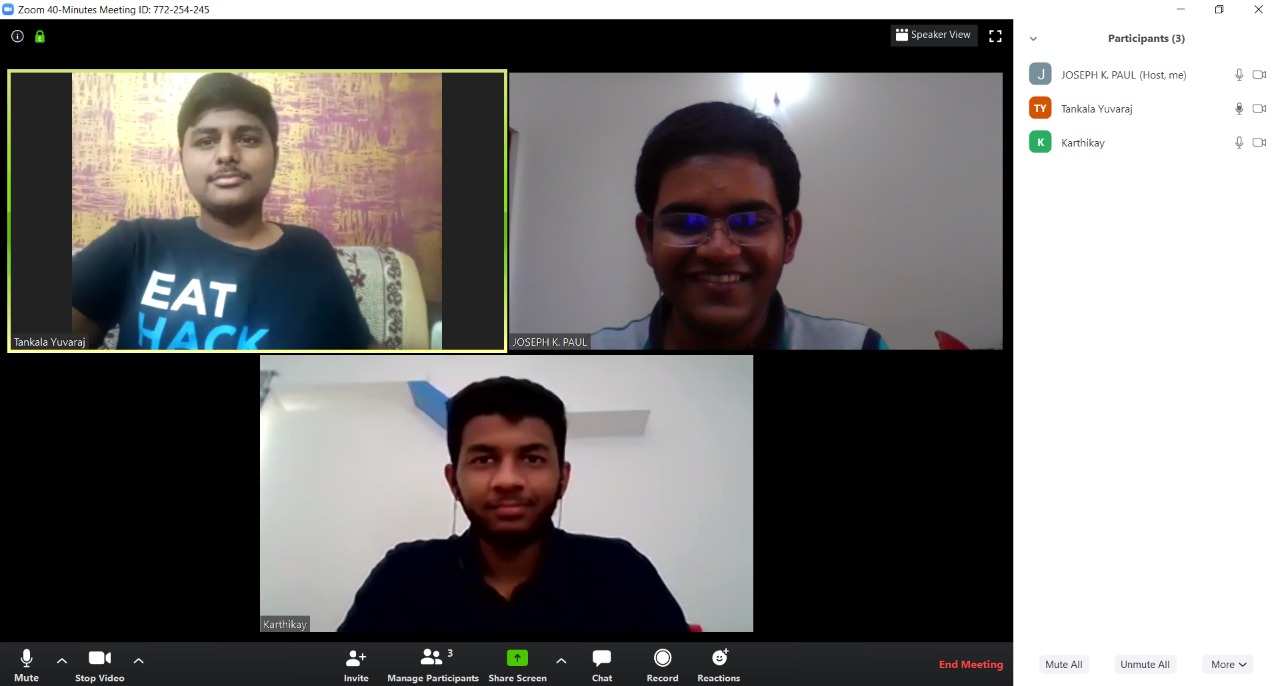 Team ASTUTE BOTS consulting
Team ASTUTE BOTS consulting
Team ASTUTE BOTS, comprising of 1st-year students, Tankala Yuvaraj, Karthikay Gundepudi and Joseph K. Paul, was recognized as the Runner-Up. They used the AI-IoT platform to develop DRONEYES; a prototyped solution that can be used to reduce poaching. It is an aerial reconnoiter which flies in stealth mode and takes the video or photo of a suspected poacher. This is done by the highly trained object detection model called YOLOv3. These eyes not only detect objects on the terra firma but also sends the exact location via GPS. “With the help of cloud technology, we can share the data in real-time so that the user/organization can take the required initiative by locating the exact place of poaching”, explains Karthikay. We were inspired to attend hackathons by Anshuman Pandey, and Next Tech Lab supported this achievement.
Another team PUSH, where Karthik Epperla, 2nd year, and Ishita Agarwal, 1st year, participated, has received the 2nd Runner’s up award. The students worked on an AI-VR-Blockchain based application to help people with autism improve communication, social and other basic abilities required to live in a society. It gives a set of YES/NO questions that are to be answered by either the parent of the child or the adult suffering from Autism and then it matches those answers with the dataset which then returns the level of autism that the child/adult is suffering from. Depending on the level, the user can choose the extremity of VR therapy. When the child goes through the VR session, the parent can view what their child/ adult is doing in the virtual environment using the parent app from anywhere and advise their ward offering extra support to the patient. ” Our application has 3D simulations of real-life situations wherein autistic children/ adults (mostly children) can practice and understand how to behave/react in those situations and overcome their fear while facing a similar situation in real life. “, adds Karthik.
Karthik acknowledges Adithya Ramakrishnan the founder of Next Tech Lab and his lab mate, Lakshmi Vallala for implanting the noble idea that AI can help in the rare medical condition, Autism. They have constantly been in touch with a few special schools and treatment centers to know about the behaviour and nature of autistic people so that they can keep on building different versions of applications.
In the natal stage of their academic career, the students are guided and nurtured in an environment by the Next Tech Lab and the faculty members which inspires them to positively impact the society. The ample exposure offered to the students will not merely encourage them, but also enable them to improve their concepts.
Continue reading → - SRM AP joins COVID-19 fight with a donation of 25 lakhs April 2, 2020
The novel coronavirus has evolved as a pandemic which forced lockdown in many countries including India. The sudden surge in symptomatic cases requires funding for medicines, diagnostic kits, research to develop vaccines, development of medical infrastructure, as well as assisting daily wagers. The entire nation has risen to assist our Indian government to raise funds for the noble cause. In the premise of supporting the government to combat the outbreak, SRM University AP, Andhra Pradesh has offered its support to the government in every way possible.
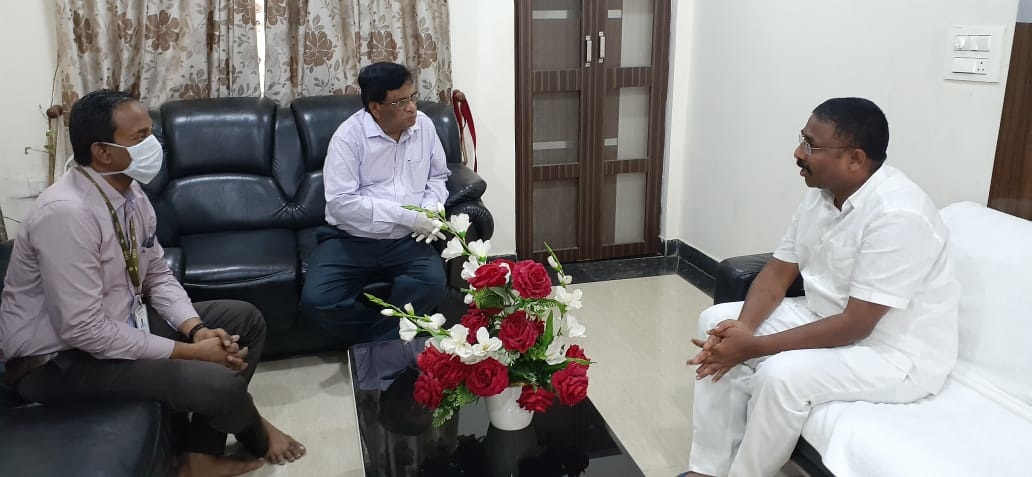 Pro VC and Director CLM in discussion with the Education Minister
Pro VC and Director CLM in discussion with the Education Minister
The contribution of 25 lakhs was handed over to the Hon’ble Education Minister Dr. Adimulam Suresh by Pro Vice-Chancellor Prof. D. Narayana Rao, Director of Campus Life and Maintenance Venkataachalam and Media PRO, Venugopal. In this distressing scenario, all the citizens of India are requested to combat against this pandemic by staying at home and taking adequate preventive measures. Dr. P Sathyanaranan, President of SRM university- AP said, “The COVID-19 Pandemic has created an unprecedented global catastrophe and a national public health emergency. In this crisis, the measures taken by the Government of Andhra Pradesh under the leadership of the Hon’ble Chief Minister to combat the COVID-19, leaving no stones unturned, is commendable.”
Earlier this week on Monday, responding to this calamity, SRM Group donated 1.15 crore on behalf of the employees of the institutes under the umbrella of the group. Dr. TR Paarivendhar, Chancellor, and Member of Parliament transferred the fund to Tamil Nadu Chief Minister’s Public Relief Fund.
SRM AP has commenced online classes to ensure that imparting of knowledge to the students is not hindered by the pandemic. View details here
Awareness Campaign on COVID-19: Coronavirus
Click here for more news articles
Continue reading →
- Novel Discoveries on CRISPR-Evading Bacteriophages April 1, 2020
Dr Sutharsan Govindarajan’s research papers published in “Nature” and “Nature Microbiology”
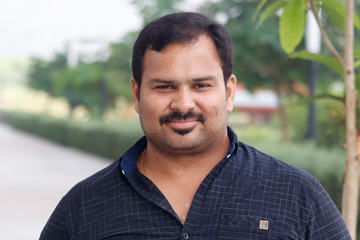 Dr Sutharsan Govindarajan, Assistant Professor of Biological Sciences at SRM University-AP has published two papers in highly reputed journals, “Nature” and “Nature Microbiology”. Both papers involve the discovery of novel strategies used by bacteriophages (viruses that kill bacteria) to overcome the bacterial CRISPR-Cas system, which are molecular scissors that are programmed to cut DNA. His findings have massive implications on the society as it has the ability to reshape the boundaries of the Phage-therapy in curing diseases.
Dr Sutharsan Govindarajan, Assistant Professor of Biological Sciences at SRM University-AP has published two papers in highly reputed journals, “Nature” and “Nature Microbiology”. Both papers involve the discovery of novel strategies used by bacteriophages (viruses that kill bacteria) to overcome the bacterial CRISPR-Cas system, which are molecular scissors that are programmed to cut DNA. His findings have massive implications on the society as it has the ability to reshape the boundaries of the Phage-therapy in curing diseases.In the paper, “A bacteriophage nucleus-like compartment shields DNA from CRISPR nucleases”, published in ‘Nature’, researchers from the University of California San Francisco, including Dr Sutharsan of SRM University-AP, discovered that certain large bacteriophages called “Jumbophages” are capable of protecting their genetic material (DNA) from being cut by the bacterial CRISPR-Cas system. In nature, the primary function of the CRISPR-Cas system, which is famous for its genome editing applications, is to cut the DNA of bacteriophages. The researchers made a surprising finding that several CRISPR-Cas enzymes were utterly ineffective in cutting the DNA of jumbophages. Subsequent studies led to the finding that these bacteriophages protect their DNA within a protein compartment called as ‘shell’. The shell provides a ‘safe room’ for the phage DNA and keeps antiviral enzymes, including CRISPR-Cas enzymes at bay. It is the first-time researchers have found that bacteriophages, which are essentially viruses, can employ one strategy to protect its DNA from many different immune systems. Dr Sutharsan says, “usually, this kind of sophisticated DNA protection mechanism is employed by complex eukaryotic cells like humans. However, our findings show that viruses, which have evolved billions of years before eukaryotic cells, also seem to be using a similar strategy. This is mind-boggling”, says Dr Sutharsan, “because our finding is making us to rethink about the current understanding of the evolution of cells on Earth.”
In another finding, which is also co-authored by Dr Sutharsan, the researchers have found a different kind of bacteriophage that protects its DNA by ‘turning off’ the production of the CRISPR-Cas enzymes in bacteria. Thus, this bacteriophage employs an entirely different strategy for the same purpose, i.e., protection of its genetic material. The paper “Bacterial alginate regulators and phage homologs repress CRISPR–Cas immunity”, got published in the journal ‘Nature Microbiology’ very recently.
Dr Sutharsan further explained how his research can play a pivotal role in the application of Phage-Therapy, which is a therapeutic strategy where bacteriophages are used to kill antibiotic-resistant bacteria and cure patients suffering from difficult-to-treat bacterial infections. Currently, the success rate of phage therapy is low, and researchers are trying to find the reasons behind this. Dr Sutharsan thinks that CRISPR-resistant bacteriophages, which he studies in his lab, can be a game-changer in phage therapy. However, this idea needs to be tested. Towards this goal, he is currently seeking collaborations with clinicians interested in phage therapy.
When asked about his future research plans, Dr Sutharsan says the “Laboratory of phage-bacteria interaction”, which I am going to establish soon at SRM University – AP, will involve in the discovery of new molecular mechanisms employed by phages and bacteria to defend against each other. Such studies have given us’ Restriction enzymes’, which started the ‘era of gene engineering’, and ‘CRISPR-Cas enzymes’, which started the ‘era of genome engineering’. We hope that our lab at the SRM University – AP will make discoveries that can take us beyond genome engineering.
References:
Nature-A bacteriophage nucleus-like compartment shields DNA from CRISPR
Nature Microbiology- Bacterial alginate regulators and phage homologs repress CRISPR–Cas immunity
Dr Sutharsan Govindarajan- https://srmap.edu.in/faculty/sutharsan-govindarajan/
Continue reading → - Pathbreaking research in genetics potent to cure disorders April 1, 2020
Dr. Sutharsan Govindarajan receives prestigious INSPIRE Faculty award
 Department of Science and Technology, Government of India has awarded Dr. Sutharsan Govindarajan, Assistant Professor, Department of Biological Sciences, SRM University-AP, the prestigious fellowship “Innovation in Science Pursuit for Inspired Research (INSPIRE)”. This initiative provides funds and a platform to potent young achievers for conducting independent research and strengthening the Science & Technology base. Dr. Sutharsan is to receive a total research grant of 35 lakhs for a period of 5 years as a DST-INSPIRE fellow.
Department of Science and Technology, Government of India has awarded Dr. Sutharsan Govindarajan, Assistant Professor, Department of Biological Sciences, SRM University-AP, the prestigious fellowship “Innovation in Science Pursuit for Inspired Research (INSPIRE)”. This initiative provides funds and a platform to potent young achievers for conducting independent research and strengthening the Science & Technology base. Dr. Sutharsan is to receive a total research grant of 35 lakhs for a period of 5 years as a DST-INSPIRE fellow.Dr. Sutharsan will establish an independent research lab at SRM University, AP, Andhra Pradesh to focus on CRISPR-Cas biology. “CRISPR technology is a powerful tool for editing genomes. It is capable of changing a single base of DNA out of billions of bases. This invention is potent to cure genetic disorders, enunciating its candidature to receive the Nobel Prize in the future.”, informs Dr. Sutharsan.
Dr. Sutharsan’s research work has the potential to nullify the single limitation of the CRISPR technology- ‘off-target’ effects i.e., unintended base changes that affects the accuracy of DNA editing. Through his research titled “Discovery of novel CRISPR-Cas silencing proteins”, he and his team intend to prevent ‘off-targets’ by identifying and characterizing the novel anti-CRISPR proteins that can inhibit in CRISPR-Cas proteins. Dr, Sutharsan believes, “This will improve the efficiency of CRISPR technology which will be highly useful for gene editing technologies, alleviating a wide range of genetic disorders and diseases in the future”.
Continue reading →

